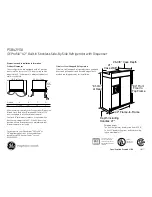
8
Style 1
Style 2
3. Depending on your model, to level your refrigerator you may
either turn the screw clockwise to raise that side of the
refrigerator or turn the screw counterclockwise to lower that
side. Place a level on top of the refrigerator to check
adjustments.
4. If the doors do not close on their own, you will need to raise
the front of the refrigerator so it is slightly higher than the
back. To do this, turn both leveling screws clockwise
¹⁄₂
turn.
IMPORTANT: Be sure to turn both screws an equal amount
or the refrigerator will no longer be level side to side.
5. Open doors and check that they close automatically. If not,
repeat steps 3 and 4.
6. Using a level, check to see that the refrigerator is still level
side to side. Readjust if necessary.
Water Supply Connection
(on some models)
Read all directions carefully before you begin.
IMPORTANT: If you turn the refrigerator on before the water line
is connected, turn the ice maker OFF.
Connecting to Water Line:
1. Unplug refrigerator or disconnect power.
2. Turn OFF main water supply. Turn ON nearest faucet long
enough to clear line of water.
3. Find a
¹⁄₂
in. (1.27 cm) to 1
¹⁄₄
in. (3.18 cm) vertical COLD water
pipe near the refrigerator.
NOTE: Horizontal pipe will work, but the following procedure
must be followed: Drill on the top side of the pipe, not the
bottom. This will help keep water away from the drill. This
also keeps normal sediment from collecting in the valve.
4. To determine the length of copper tubing you will need,
measure from connection on lower left rear of refrigerator to
water pipe. Add 7 ft (2.1 m) to allow for moving refrigerator for
cleaning. Use
¹⁄₄
in. (6.35 mm) O.D. (outside diameter) copper
tubing. Be sure both ends of copper tubing are cut square.
5. Using a grounded drill, drill a
¹⁄₄
in. (6.35 mm) hole in the cold
water pipe you have selected.
6. Fasten shutoff valve to cold water pipe with pipe clamp. Be
sure outlet end is solidly in the
¹⁄₄
in. (6.35 mm) drilled hole in
the water pipe and that washer is under the pipe clamp.
Tighten packing nut. Tighten the pipe clamp screws carefully
and evenly so washer makes a watertight seal. Do not
overtighten or you may crush the copper tubing, especially if
soft (coiled) copper tubing is used. Now you are ready to
connect the copper tubing.
7. Slip compression sleeve and compression nut on copper
tubing as shown. Insert end of tubing into outlet end squarely
as far as it will go. Screw compression nut onto outlet end
with adjustable wrench. Do not overtighten.
8. Place the free end of the tubing into a container or sink, and
turn ON main water supply and flush out tubing until water is
clear. Turn OFF shutoff valve on the water pipe. Coil copper
tubing.
Connecting to Refrigerator:
NOTE: The first step for connecting the water line to your
refrigerator is different depending on the type of water valve
provided with your refrigerator. See the diagrams below to
determine the style of valve you have. (On kit models, assemble
water valve to refrigerator per kit instructions.)
1. For Style 1, disconnect the tube clamp on the back of the
product and insert the copper tubing through the clamp, as
shown. Remove the tape label from the valve inlet and insert
copper tubing until it bottoms out (approximately
³⁄₄
in.
[1.9 cm]). Tighten nut by hand as much as possible; then turn
the nut an additional
¹⁄₂
turn using a wrench. Do not
overtighten. Reattach the tube clamp and tube to the back of
the cabinet. Skip to Step 2.
For Style 2, disconnect the tube clamp on the back of the
product and insert copper tubing through the clamp as
shown. Attach the copper tube to the valve inlet using a
compression nut and sleeve as shown. Tighten the
compression nut. Do not overtighten. Reattach the tube
clamp and tube to the back of the cabinet. Move to Step 2.
2. Turn shutoff valve ON. Check for leaks. Tighten any
connections (including connections at the valve) or nuts that
leak.
Style 1
1. Cold Water Pipe
2. Pipe Clamp
3. Copper Tubing
4. Compression Nut
5. Compression Sleeve
6. Shutoff Valve
7. Packing Nut
1. Tube Clamp
2. Copper Tubing
3. Compression Nut
4. Valve Inlet


































